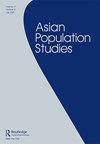Missing marriage: changing marriage patterns amid social transition in Myanmar
IF 1.5
4区 社会学
Q2 DEMOGRAPHY
引用次数: 2
Abstract
ABSTRACT Across Asia, men and women increasingly delay or abstain from marriage, a change often linked to improvements in female educational attainment and labour force participation. In Myanmar, less than 90 per cent of women aged 45–49 years during the 2014 census had ever married, compared to nearly all men of a similar age. This paper investigates the difference in marriage patterns between males and females in Myanmar. Using a Cox proportional hazards model, we analyse the associations between entry into marriage across age cohorts, and male and female educational attainment and workforce participation. We find that having a high level of education and currently working negatively affect women's chances of marrying across all ages. While higher education similarly affects younger men, we find that higher socioeconomic status substantially improves a man's likelihood of marriage in later life, suggesting lingering gender stereotypes influencing women to remain single in the country.失踪婚姻:缅甸社会转型中婚姻模式的变化
摘要在整个亚洲,男性和女性越来越多地推迟或放弃结婚,这一变化往往与女性受教育程度和劳动力参与度的提高有关。在缅甸,2014年人口普查期间,45至49岁的女性中只有不到90%结婚,而几乎所有年龄相仿的男性都结婚了。本文调查了缅甸男女婚姻模式的差异。使用Cox比例风险模型,我们分析了不同年龄组结婚与男性和女性教育程度和劳动力参与之间的关系。我们发现,拥有高水平的教育和目前的工作对各个年龄段的女性结婚机会都有负面影响。虽然高等教育同样影响年轻男性,但我们发现,较高的社会经济地位大大提高了男性在晚年结婚的可能性,这表明挥之不去的性别刻板印象影响着女性在该国保持单身。
本文章由计算机程序翻译,如有差异,请以英文原文为准。
求助全文
约1分钟内获得全文
求助全文
来源期刊

Asian Population Studies
DEMOGRAPHY-
CiteScore
3.30
自引率
14.30%
发文量
12
期刊介绍:
The first international population journal to focus exclusively on population issues in Asia, Asian Population Studies publishes original research on matters related to population in this large, complex and rapidly changing region, and welcomes substantive empirical analyses, theoretical works, applied research, and contributions to methodology.
 求助内容:
求助内容: 应助结果提醒方式:
应助结果提醒方式:


